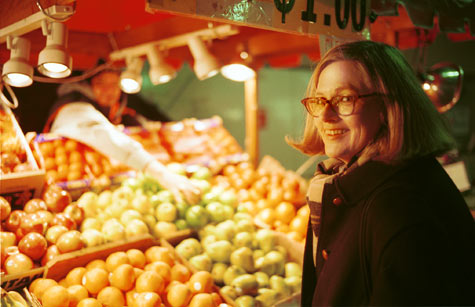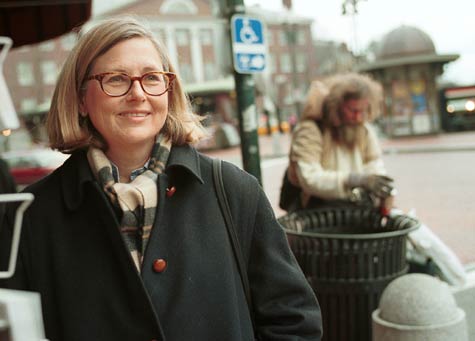Outlaw entrepreneurs:
Urban design professor supports street vendors use of public space

A woman selling tamales from a shopping cart in East L.A., a vendor of religious pictures on the median strip of La Brea Avenue, a father and son who have turned the front yard of their Watts home into a mattress showroom – to most city planners, government officials, and others responsible for maintaining the warp and weft of the urban fabric, sights such as these are anathema, a sign of chaos, the breakdown of civil authority.
But that isn’t how Margaret Crawford sees them. Crawford, who joined the faculty of the Graduate School of Design this year as professor of urban design and planning theory, believes that these outlaw entrepreneurs are helping to restructure and revitalize the city, not destroy it. In a city like Los Angeles, where she lived and worked for most of her life, Crawford sees street vendors and garage sale proprietors as creators of something which is in extremely short supply – viable public space.
“The question is, how is public space to be created – by designers, by the state, or by the people who use it?” she asked.
As a theorist of urban design, Crawford is something of an outlaw herself. Her position dissents from the predominant view, which bemoans the loss of public space and makes dark predictions about how that loss is contributing to the erosion of democratic values.
According to this school of thought, of which Crawford once counted herself a member, the public spaces of old where citizens gathered to discuss the issues of the day – the courthouse squares, the village markets – have by now pretty much vanished. The only thing taking their place is the local shopping mall, an artificial construct devoted to commercialism, not citizenship.
As a devotee of this view, Crawford contributed a chapter to a book by urban design critic Michael Sorkin, “Variations on a Theme Park: the New American City and the End of Public Space” (1990). Crawford’s chapter developed the idea that the entire world had become a gigantic shopping mall.

Since that time, Crawford has taken another look at the city and come to a different set of conclusions.
“I don’t think public space is dead, just changing. We can’t even say what public space is. In fact, there are different public spaces that address different publics.”
Crawford calls the process by which groups use unauthorized means to transform the urban landscape “reterritorialization.” She is well aware that it is a highly contested issue.
“Traditionally, the whole mission of urban planning is to create a clean and orderly city. In fact, speaking as a middle-class person, I find a lot of these things annoying. So I understand the traditional point of view. It’s just that the other viewpoint has to be looked at as well.”
A few years ago, Crawford and several like-minded colleagues decided to explore this controversial perspective, that positive change in the city might emerge from apparent chaos and lawlessness. They ventured out into the neighborhoods of Los Angeles to look more closely at the kind of urban landscapes that most critics ignore. Crawford and her fellow editors John Chase and John Kaliski have collected these observations and conclusions in the book “Everyday Urbanism” (1999).
As a result of her research, Crawford has come up with some surprising perspectives on the commercial activities that take place in Los Angeles’ poorest neighborhoods as well as its most affluent.
Selling used merchandise at garage sales is a flourishing business in many parts of the city. Although city ordinances generally impose limits on the number of sales an individual can hold per year, these limits are frequently ignored, and yard sales sometimes become permanent, in effect a store on private property.
Garage and yard sales tend to intersect with other venues at which used goods are sold, such as flea markets and antique stores.
“There’s an entire informal economy that’s very rich and that brings about a lot of cross-class activity. It’s a whole neighborhood web held together by used things.”
Crawford herself has taken part in this web, as a buyer of used clothing for her young daughter as well as a donator of goods to the women entrepreneurs she has studied. She learned how some women have converted their basements into stockrooms and how others use their network of connections to find specific items for their clients. Many allow regular customers to buy on credit while some take a step beyond the used clothing market and buy stock from garment manufacturers.
“Garage sales change the meaning of the single-family house,” Crawford said. “They activate the front yard, which is usually a buffer space, and break down boundaries between public and private. The blurring of boundaries leads to new ways of conceptualizing these areas.”
Many of these entrepreneurs are Hispanic, part of the city’s huge minority population. In fact, the term “minority” is hardly applicable at this point because California recently became the first state in which people classified as non-white are more numerous than those classified as white.
Minorities are still economically and politically disadvantaged, however, and Crawford sees the activities of these sellers as a way of claiming space and, with it, the rights of citizenship. She points to the example of street vendors, most of them illegal immigrants, who have fought for the right to be accepted as entrepreneurs rather than branded as criminals. Such actions are doubly risky since drawing the attention of the authorities could result in deportation.
“These activities seem trivial, but what they show is a demand to use space, which can be seen as a new form of urban citizenship. For many of these people, this type of action is more significant than electoral politics,” Crawford said.
Nor are yard sales confined to the poorest sections of Los Angeles. During the early 1990s, when real estate prices plummeted, leaving many homeowners with mortgages they could no longer afford, yard sales sprouted along the manicured streets of Beverly Hills. Owners of million-dollar homes could be seen offering leather jackets and other luxury goods at bargain prices.
The struggle of vendors to claim space for their business activities can be seen in other cities as well. Mayor Giuliani’s efforts to clear New York City’s streets of unauthorized entrepreneurs are well known, and in Florence, Italy, which Crawford frequently visits with her Italian-born husband, the streets are filled with vendors from Senegal. An effort has been made to confine them to a specially designated marketplace where they can sell native crafts, but this solution has largely failed. Few of them in fact sell crafts, but rather knockoffs of Prada bags and Cartier watches.
Crawford, who teaches a course called “Contemporary Urban Dynamics,” sees such issues as the result of changes in the worldwide economy.
“This is really about how to deal with globalization and the demands it puts on a city,” she said.
But there is also an aspect to these struggles over space that recapitulates class conflicts of the past.
“American cities have been characterized throughout history by these conflicts. In the past you find people of gentility being disturbed by the behavior of the ‘lower orders.’ They were too loud or they gestured too broadly. This is just a new chapter in the struggle.”
Now that she has moved to the East Coast, Crawford is just beginning the task of learning to “read” Cambridge and surrounding areas and to discern their underlying dynamics. What challenges her understanding here is the weight of the past, a burden that does not affect the West Coast to the same degree. There the emphasis is on the present and future.
“In L.A., the future is ever-present. That’s what makes it both scary and exhilarating. It’s endlessly unknowable. No one’s been able to explain it, or, rather, there are multiple explanations, and probably all of them are true. That’s what makes it a gold mine for urban scholars.”




